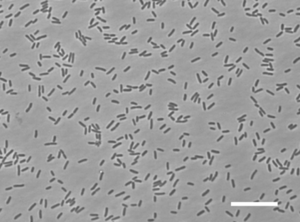Gemmatimonas aurantiaca
A Microbial Biorealm page on the genus Gemmatimonas aurantiaca
Classification
Higher order taxa
Bacteria; Gemmatimonadetes; Gemmatimonadales; Gemmatimonadaceae; Gemmatimonas.
Species
Gemmatimonas aurantiaca T-27
Description and significance
G. aurantiaca T27 is an aerobic rod-shaped Gram-negative bacterium that is non-sporulating. It is motile by the use of flagella and it was isolated by anaerobic-aerobic sequential batch reactor under enhanced biological phosphorus removal conditions for wastewater treatment. G. aurantiaca T27 is a very slow growing bacterium and is a polyphosphate-accummulating bacteria.
Genome structure
Describe the size and content of the genome. How many chromosomes? Circular or linear? Other interesting features? What is known about its sequence?
Cell structure and metabolism
Interesting features of cell structure; how it gains energy; what important molecules it produces.
Ecology
Habitat; symbiosis; contributions to the environment.
Pathology
How does this organism cause disease? Human, animal, plant hosts? Virulence factors, as well as patient symptoms.
Current Research
Enter summaries of the most recent research here--at least three required
Cool Factor
Describe something you fing "cool" about this microbe.
References
Gemmatimonas aurantiaca T-27." Genome Information Broker. Web.
Zhang, Hui, Yuji Sekiguchi, Satoshi Hanada, Philip Hugenholtz, Hongik Kim, Yoichi Kamagata, and Kazunori Nakamura. "Gemmatimonas Aurantiaca Gen. Nov., Sp. Nov., a Gram-negative, Aerobic, Polyphosphate-accumulating Micro-organism, the First Cultured Representative of the New Bacterial Phylum Gemmatimonadetes Phyl. Nov." International Journal of Systematic and Evolutionary Microbiology.
Edited by student of Iris Keren: NEUS2012 Amal Mohamed, Soonji Kim, Jaclyn Egitto


